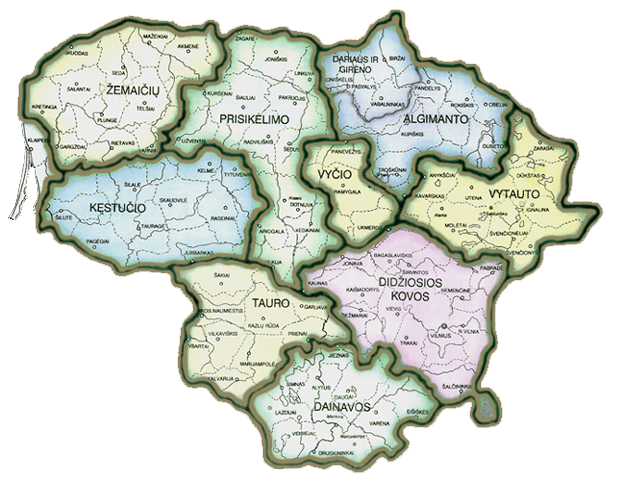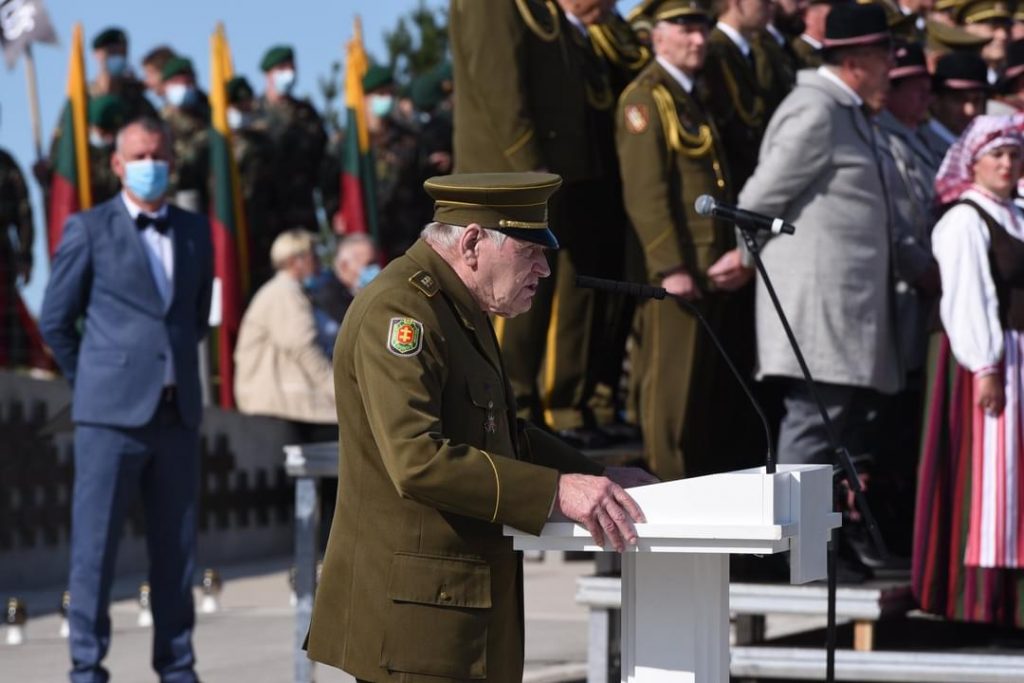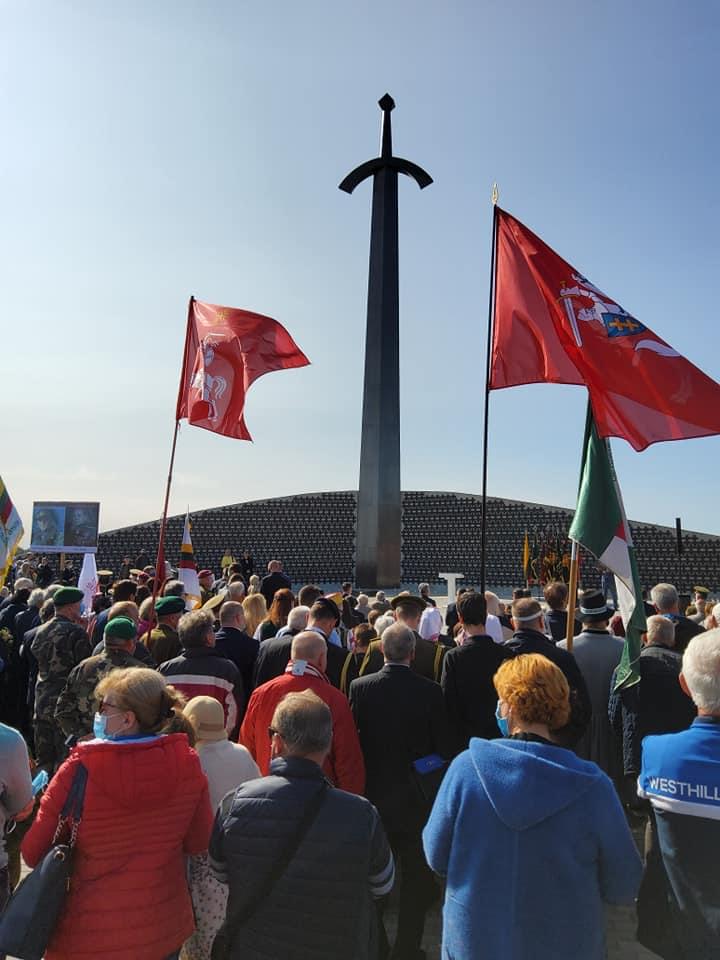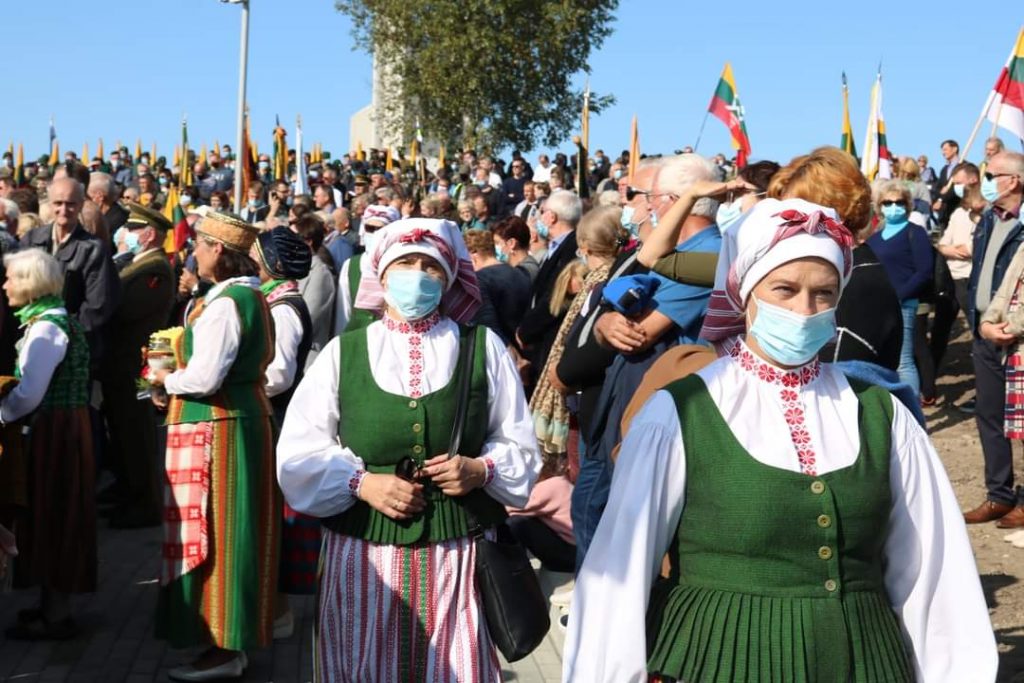Partisan districts

Dainava district
Established in November 1945 (until 16 May 1946 it was called the “A” district). They were active in Alytus, partly in Lazdijai counties. At the beginning, the district comprised 3 squads, in 1946 – 2, since June 1947 – again 3 (Dzūkai, Kazimieraitis and Šarūnas) squads. The first commander of the district and its founder, lieutenant colonel Juozas Vitkus-Kazimieraitis began centralizing the units of Lithuanian partisans; in April 1946, he founded the Joint Staff of the Partisans of South Lithuania, which included Dainava and Tauras districts, announced the first political declaration of partisan leaders. Partisans of the district, Jurgis Krikščiūnas-Rimvydas and Kazimieras Pyplys-Mažytis through the “Iron Curtain” had communicated to the Western world information about the partisan fighting. The district published newspapers “Aukuras” (“The Altar”), “Laisvės varpas” (“The Bell of Freedom”). Significant battles: 17 May 1945, in Alytus county Simnas neighbourhood Kalniškės forest (44 partisans were killed); 14 June 1945, Daugai neighbourhood Varčia forest (1st Varčia battle, 2nd Varčia battle) (40 partisans were killed and arrested). The district was commanded by Juozas Vitkus-Kazimieraitis (November 1945 – May 1946), Dominykas Jėčius-Ąžuolis (May 1946 – August 1947), Adolfas Ramanauskas-Vanagas (August 1947 – September 1948), Benediktas Labėnas-Kariūnas (September 1948 – March 1949), Lionginas Baliukevicius-Dzūkas (May 1949 – June 1950), Juozas Gegužis-Diemedis (June 1950 – September 1951), Vincas Daunoras-Ungurys (September 1951 – May 1952). As a result of the death of the officers and actions of the MGB provocateurs, the district essentially ceased to exist in August 1952. Former Commander of the district, Chief Commander of the Defence Forces of the Lithuanian Freedom Fighting Movement, Adolfas Ramanauskas, was arrested in 1956, executed on 29 November 1957.
Didžioji Kova (The Great Fight) district
It was active since the summer 1944, officially established in April 1945, at the initiative of Jonas Misiūnas-Žalias Velnias (Green Devil). Was active in Vilnius, Kaunas, Ukmergė counties. The district comprised the A and B squads. 1944-1945 partisans of the district carried out numerous military operations, destroyed Soviet garrisons and administrative offices of smaller towns. Major battles: February 1945, Švenčionys county Pabradė neighbourhood; 20 March 1945, Ukmergė county Vepriai neighbourhood (36 partisans were killed), etc. In 1946, after the MGB infiltrated a provocateur into the district leadership, the A squad was almost completely destroyed, the B squad worked independently. In May 1948, the squad was granted the rights of a district. The district was commanded by J. Misiūnas-Žalias Velnias (September 1944 – January 1945, and April 1945 – July 1946), Mykolas Kareckas-Serbentas (January 1945 – April 1945), Alfonsas Morkūnas-Plienas (August 1948 – 30 December 1949). Published the newspaper “Tėvynei šaukiant” (“As Homeland is Calling”). By the order of the Commander of the region of 25 November 1950, the Didžioji Kova district was dissolved.
Vytis district
Established by the end of 1944 (named “Vytis” in the summer of 1945). Was active in Panevėžys, Ukmergė, and partly in Kėdainiai counties. The district consisted of Briedis and Krištaponis squads; in 1951 they were merged into one, Gediminas squad. Published the newspaper “Lietuva brangi” (“Dear Lithuania”). Major battles: 09 February 1945, in Panevėžys county, Troškūnai neighbourhood (68 partisans were killed); 27 March 1945, in Panevėžys county, Pušalotas neighbourhood, Ažagai forest (75 partisans were killed). The district was commanded by Captain Juozas Krištaponis (December 1944 – 12 January 1945), Lieutenant Danielius Vaitelis-Briedis (February 1945 – May 1948), Alfonsas Smetona-Žygaudas (May 1948 – July 1950), Mykolas Šemežys-Putinas (July 1950 – April 1951), Bronius Karbočius-Algimantas (September 1951 – January 1953). After Bronius Karbočius was killed on 26 January 1953, the staff of the district was not restored. The last partisans were killed in 1956.
Algimantas district
Established on 1 May 1947, by the decision of partisan commanders of the Eastern Lithuania region, from partisan units that were active in Panevėžys and Rokiškis counties, and belonged to Vytautas district. Algimantas district comprised 3 squads: Šarūnas, Duke Margis and Žalioji (The Green). In the territory of the district, in Šimoniai Forest, the leadership of the region was based, and meetings of commanders were organized. The district published newspaper “Partizanų kova” (“Partisan struggle”). Algimantas district was commanded by Antanas Slučka-Šarūnas (May 1947 – October 1948) and Antanas Starkus-Montė (October 1948 – 01 November 1949). In the autumn 1949, the headquarters of the district and Šarūnas squad were destroyed. By the order of the Commander of the region of 25 November 1950, the Algimantas district was dissolved. The remaining fighters of Šarūnas and Duke Margis squads were joined into one – Tumas Vaižgantas squad, and included in Vytautas district, while fighters of Žalioji squad were included in Vytis district.
Vytautas district
Established in August 1945. It was active in Švenčionys, Utena, Rokiškis counties. 3 squads belonged to the district: Tigras (Tiger), Lokys (Bear) and Liūtas (Lion, called Šarūnas until 1946). Major battles: “Šilas” battle in the Antazavė Forest on 26 December 1944, fights in the Labanoras Forest near Kiauneliškis Railway Station on 10-12 March 1945 (about 80 partisans were killed). Published the newspaper “Aukštaičių kova”. Vytautas district was commanded by Jonas Kimštas-Dobilas (August 1945 – October 1946 – June 1947), Vladas Mikulėnas-Lubinas (September 1945 – December 1945), Bronislovas Zinkevičius-Artojas (December 1945 – 11 October 1946), Vincas Kaulinis-Miškinis (June 1947 – March 1949), Bronius Kalytis-Siaubas (March 1949 – December 1951). The district was destroyed after the MGB captured its commander Bronius Kalytis and forced him to change sides. Antanas Kraujelis-Siaubūnas, the last partisan of the district, was killed in 1965, and Stasys Guiga stayed in hiding and died in 1986.
Tauras district
Established 15 August 1945 in Marijampolė county, in Skardupiai, at the initiative of priest Antanas Ylius. Was active in Marijampolė, Šakiai, Vilkaviškis and Kaunas counties. Until 1949, there were 5 squads in Tauras district, later only 3 were left: Vytautas, Geležinis Vilkas and Žalgiris. The district published newspaper “Laisvės žvalgas” (“Freedom Scout”), was one of the first to introduce military uniforms, has written many of partisan statutes, and in 1947, organized partisan training in the forests of Kazlų Rūda. The district was commanded by Leonas Taunys-Kovas (August 1945 – October 1945), Zigmas Drunga-Mykolas, Jonas (October 1945 – June 1946), Antanas Baltūsis-Žvejas (July 1946 – February 1948), Jonas Aleščikas-Rimantas (April 1948 – August 1948), Aleksandras Grybinas-Faustas (August 1948 – September 1949), Viktoras Vitkauskas-Saidokas (October 1949 – February 1951), Juozas Jankauskas-Demonas (April 1951 – June 1952). Tauras district was distinguished in the work of centralization of partisan units. On 19 January 1947, Antanas Baltūsis-Žvejys convened a meeting of partisan commanders and decided to restore the Presidium of the General Democratic Resistance Movement, established contacts with all partisan districts and emigrant organizations. In 1947, Juozas Lukša was sent abroad. The last partisan of the district, Justinas Balčius-Plutonas was killed in 1957.
Žemaičiai district
The district was established in March 1945 (until May 1946, was known as the Samogitian Legion) from partisan groups operating in Telšiai, Kretinga, Mažeikiai counties, and partly in Tauragė county. The district comprised 3 squads: Kardas, Alka and Šatrija. published newspapers “Laisvės balsas” (“Freedom Voice”), “Kovojantis lietuvis” (“Fighting Lithuanian”), “Malda girioje” (“Prayer in the Forest”). Significant actions: 25 December 1945, attack on Endriejavas town (1950 attacked once again). On 8 June 1948, Veiviržėnai was liberated within three hours, the tricolour flag was raised and institutions of the occupying authorities were destroyed. The district was commanded by Adolfas Kubilius (March 1945 – September 1945), Jonas Semaška-Liepa (September 1945 – April 1946), Fortunatas Ašoklis-Pelėda (May 1946 – September 1946), Kazys Antanavičius (September 1946 – 09 April 1947), Kazys Juozaitis-Meteoras and Juozas Ivanauskas-Vygantas (April 1947 – October 1947), Vladas Montvydas-Žemaitis (March 1948 – 23 August 1953). Headquarters of the district were destroyed on 29 August 1953; the staff member Irena Petkutė, editor of the press, was surrounded and shot herself. The last partisan of the district, Pranas Končius-Adomas, was killed on 15 July 1965.
Kęstutis district
It was established on 12 September 1946 (until April 1948, it was called the United Kęstutis District) from partisan units that were active in Tauragė, Raseiniai, Jurbarkas, Šiauliai, Joniškis, partly Kėdainiai and Kaunas counties. At the beginning, even 6 squads were included in the district; in April 1948, after the establishment of the Prisikėlimas (Resurrection) District, there were 3: Butegeidis (formerly called Lydys, Aukuras), Birutė (formerly known as Žebenštis, Šernas, Savanoris, Knygnešys) and Vaidotas (formerly Žaltys, Naras). Published the newspaper “Laisvės varpas” (“Freedom Bell”). Major battles: Virtukai battle on 22 July 1945 in Raseiniai county, Lioliai neighbourhood (15 partisans were killed). The district was commanded by Juozas Kasperavičius-Visvydas (12 September 1946 – 12 April 1947), Jonas Žemaitis-Tylius (25 May 1947 – July 1948), Henrikas Danilevičius-Vidmantas (July 1948 – April 1949), Aleksas Miliulis-Neptūnas (April 1949 – June 1949), Antanas Bakšys-Klajūnas (June 1949 – August 1951), Krizostomas Labanauskas-Justas (August 1951 – May 1952), Povilas Morkūnas-Rimantas (May 1952 – June 1953). The last partisans of the Kęstutis district were killed in 1959.
Prisikėlimas (Resurrection) district
Established on 01 April 1948, after the United Kęstutis District was split into two districts. Prisikėlimas district included partisan units that were active in the central part of Lithuania (Šiauliai, Joniškis, partly Kėdainiai, Panevėžys and Raseiniai counties). The district comprised 3 squads: Duke Žvelgaitis (formerly known as Voverė (Squirrel)), Maironis (formerly – Povilas Lukšys) and Lietuvos žalioji (Lithuanian Green) (it included the Atžalynas squad). The district published newspaper “Prisikėlimo ugnis” (“Resurrection Fire”). In its territory (Radviliškis area, Mėnaičiai village), 10-20 February1949, congress of all Lithuanian partisan leaders took place, the Lithuanian Freedom Fighting Movement (LFFM) was established, chief command of partisan was formed, and political declaration of 16 February 1949 was issued. In the Prisikėlimas district, the public part of the LFFM was based, press releases of the chief command were published, communication with all partisan areas was maintained. With the lack of staff officers, on 20 May 1952, the Prisikėlimas district was dissolved by the order of the Western region, and the remaining surviving fighters were transferred to the Kęstutis district. As an organized unit, partisans of the Duke Žvelgaitis squad, Juozapavičius team, survived for the longest time, they were publishing newspaper “Partizanų šūvių aidas” (“The Echo of Partisan Shots”) until 1957. The last partisan of the district, Pranciškus Prūsaitis, was arrested and executed in 1963. The district was commanded by Petras Bartkus-Žadgaila (April 1948 – August 1948), Leonardas Grigonis-Užpalis (August 1948 – August 1949), Povilas Morkūnas-Rimantas (August 1949 – August 1951), and the last commander of the district, Juozas Paliūnas-Rytas (August 1951 – 20 May 1952).














